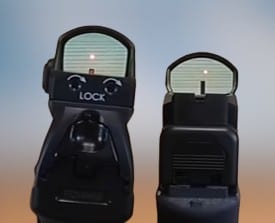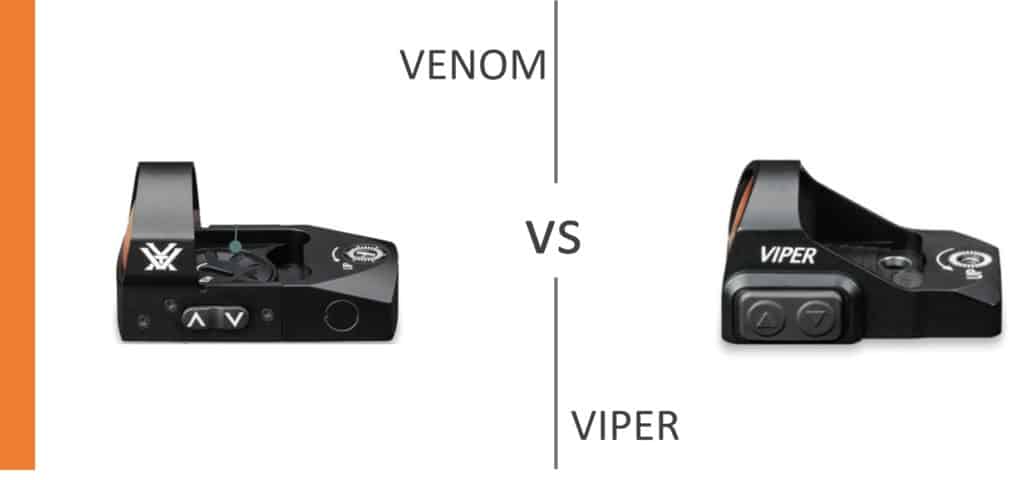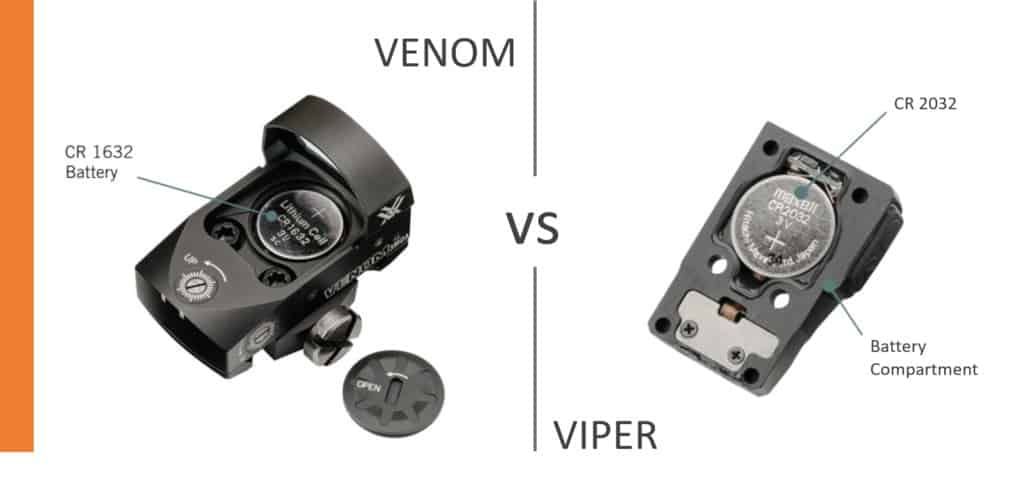In this review of the Vortex Venom vs Viper, we will do a side-by-side comparison of these two popular red dot sights.
We will cover all the top features for both reflex sights as well as the specifications and frequently asked questions.
Be sure to read the whole review so you can get our recommendation as to which one of these optics is the best.
Both the Venom and Viper red dot sights are manufactured by Vortex Optics, based in Barneveld, Wisconsin.
Founded in 2004, Vortex Optics produces several types of precision optical equipment such as scopes, binoculars, red dot sights, as well as other related accessories.
Over the years, Vortex Optics has become known for quality products, and its red dot sights are no exception.

Vortex Venom vs Viper Review
First, let’s get the basic similarities of these two sights out of the way.
Both sights are machined from a single piece of aluminum, making them lightweight yet rugged. The exterior of each of these red dot sights is finished with a matte black anodized coating.
Additionally, the lenses are multi-coated with an anti-reflective coating that helps increase light transmission for a quality viewing experience.

The Venom and the Vortex Viper are easy to operate and are engineered to withstand recoil and impact forces. The design and construction of these reflex sights make them suitable for pistol, shotgun, carbine and rifle applications in almost any environment.
Vortex Optics stands behind the Venom and the Viper with their VIP Warranty to repair or replace the optic at no charge.
Okay, now that we go to the basic similarities out of the way lets get to the differences between the optics.
If you are looking for a complete review of the Venom you can check out the full review here
Optic Body Size
With respect to physical size, the Vortex Venom vs Viper is just a tad bit larger in size and weight.
The Venom is slightly longer and wider than the Vortex Viper. Also, the profile of the Venom base is taller than that of the Viper.

Two obvious things here with respect to the size. The Venom has a wider Field of View (FOV), but most shooters prefer the Vipers taller viewing window that has a larger viewing surface, due to its thinner base profile.
Additionally, the Viper’s lower base profile allows for co-witness on pistols with silencer height iron sights.
The weight of the Venom is 1.1 oz while the Viper weighs in at 1.03 oz. Not enough of a difference here in weight that would have any real effect when shooting.
We are going to give the win to the Vortex Viper here for a shorter base height and .6723 inch viewing surface over the Venom’s .6547 inch viewing surface.
Red Dot Reticle
Both optics are illuminated via a red light-emitting diode (LED). The Venom red dot sight is available in a 3 MOA or a 6 MOA reticle model while the Viper is only available in a 6 MOA model.

The 3 MOA reticle option makes the Venom more suitable for shooting platforms where you intend to engage targets out to an intermediate-range. A small reticle dot does enable better precision at further distances.

Dot size is a personal preference, but generally speaking, a larger dot is more suitable for close-quarters engagements that are more common with a pistol.
This round goes to the Vortex Venom with two reticle size options versus the Vipers single reticle size options.
Operation
The optics have easy to reach side-mounted controls that are intuitive to operate. From these controls, you can turn the optics off /on and adjust the reticle brightness settings

The Venom and the Viper have 10 reticle brightness settings that can cover a wide array of light conditions.
With the Venom, you get the additional functionality of an auto mode. When you place the Venom in auto-mode the optic adjust the reticle brightness based on the current ambient light conditions
The Venom and Viper will both power down after 14 hours. This helps in prolonging battery life.
Okay in Vortex Venom vs Viper operation the Venom takes the win. We know that not everyone likes auto-brightness, but it is there if you want it, so we are giving this one to the Venom red dot sight.
Batteries
According to Vortex Optics, both the Venom and the Viper have a battery life of 150 hours when using the highest brightness setting and 30k hours when used at the lowest setting.

The Vortex Venom utilizes a CR 1632 lithium coin battery, while the Viper utilizes and CR 2032 lithium coin battery.
The battery compartment for the Venom is located on the top of the optic make access easy and battery changes simple and fast.
The Venom’s battery compartment is located under the sight, similar to a Trijicon RMR. This requires you to remove the sight every time you need to change the battery.
This is going to be an easy win for the Vortex Venom. Not having to remove the sight to replace the battery means you don’t have to re-zero the optic every battery change.
Sight Adjustment
The Venom and the Viper have similar elevation and windage adjustment controls. Each click of adjustment is equal to 1 MOA for both sights.

The Viper has 120 MOA adjustments for the elevation and the windage. The Venom has 100 MOA adjustments for elevation and windage.
The Vortex Viper also incorporates locking screws for the elevation and windage adjustment to insure the sight stays dialed in and you don’t lose your zero.
Access to the locking screws may be inhibited when employing the Viper on a pistol while maintaining the rear iron sights.
This round is going to the Viper, even if it is only by a slight margin, for the additional MOA adjustments increments and the adjustment locking screws.
Mounting
The Vortex Venom and Vortex Viper red dot sights are suitable for almost any firearm application.
Out of the box, the Venom is ready to mount on a Picatinny spec base rail with the included low rail mount.
The Viper comes with a low rail mount that clamps to both a Weaver or Picatinny spec base rail.

When mounting on a pistol the Venom and Viper are compatible with Burris Fastfire/Docter footprint cutouts. Be sure to check the manufacturer for the proper mounting plate.
While both the Vortex Venom and the Viper red dot sights are great red dots sights for pistols there are a few things to consider.
When attempting to achieve co-witness with the Vortex Viper you may block the adjustment locking screw and will be unable to make windage or elevations adjustments. You could overcome this if you have your rear sights mounted forward of the optic.
The one advantage the Viper has when mounting on a pistol is its lower base profile. This makes the Viper better suited for a lower profile when using a dovetail type mounting plate.
In the mounting category with the Venom Vortex vs Viper, we are going to call this a draw.
Vortex Venom vs Viper Specifications
| Spec | Venom | Viper |
| Reticle | 3 MOA or 6 MOA | 6 MOA |
| Brightness Setting | 10 Levels | 10 Levels |
| Light Source | LED | LED |
| Magnification | 1X | 1X |
| Unlimited Eye Relief | Yes | Yes |
| Multi-Coatings | Yes | Yes |
| Battery Type | CR1632 | CR2032 |
| Battery Life | 150hr @Highest setting | 150hr @Highest setting |
| Water Resistance Level /Depth | Waterproof/1M | Waterproof/1M |
| Adjustment per Click | 1 MOA | 1MOA |
| Windage Adjustment | 100 MOA | 120 MOA |
| Elevation Adjustment | 130 MOA | 120 MOA |
| Housing Material | Aluminum | Aluminum |
| Surface Finish | Anodized Finish | Anodized Finish |
| Weight (oz) | 1.1 oz | 1.03 |
| Window Size | .6547 inch area | .6723 inch area |
| Dimension (l x w x h) inches | 1.9 x 1.11 x 1.02 | 1.81 x 1.06 x 1.02 |
Included with the Venom and Viper
Vortex Venom
- (1) Vortex Optics Venom Red Dot Sight (VMD-3103)
- (1) Weaver / Picatinny mount
- (1) T-15 Torx wrench
- (1) Rain cover
- (1) Lens cloth
- (1) Mounting screws
- (1) CR 1632 battery
- (1) Screwdriver
Venom manual here
Vortex Viper
- (1) Vortex Optics Viper Red Dot Sight (VRD-6)
- (1) Weaver / Picatinny mount
- (1) T-10 Torx wrench
- (1) Rain cover
- (1) Lens cloth
- (1) CR 2032 battery
- (1) Flathead wrench
Viper manual here
Pros vs Cons
Okay, its time to highlight the pros and cons for each of these Vortex Optics red dot sights. After we will take a look at the most frequently asked questions and provide our conclusion.
The Pros
The Vortex Venom red dot sight shines when it comes to battery compartment location making battery changes simple and fast.
The Vortex Viper red dot sight has an excellent FOV for a sight in this class size.
The Viper also has a very small profile that makes co-witness easy to achieve with suppressor height iron sights
The Venom includes an auto mode reticle brightness feature that makes keeping the reticle level easy for any ambient light condition.
Both the Venom and Viper will mount in most optic ready pistols.
The Cons
The Viper’s battery compartment located under the sight requires you to remove the sight and re-zero after each battery change.
The Vortex Venom reflex sight has a smaller FOV the could increase reticle acquisition time compared to the Viper.
The Vortex Viper only comes in a 6 MOA reticle size model limiting it effective employ at further distances.
Frequently asked Questions
The major differences between the Vortex Venom vs Viper are:
-Size, the Venom is larger than the Viper.
-Field of View, the Viper has a larger FOV than the Venom.
-Battery Type, The Venom uses a CR 1632 while the Venom uses a CR 2032.
-Battery Compartment, The Venom’s battery compartment is located on top while the Viper’s is located underneath.
The Vortex Venom shares the same footprint as the Burris Fastfire/Docter.
The Venom according to Vortex Optics is waterproof, although they do not provide the specifics to derive the equivalent IPX rating.
The Vortex Venom comes with an auto shut off feature that powers down the optic after 14 hours.
The Vortex Viper will fit and mount on a Glock MOS with the proper plate, screws, and gasket.
Conclusion
In the Vortex Venom vs Viper head to head comparison, the Venom wins with a slight edge over the Viper. This is not to say that the Viper is not an excellent choice when considering a Micro Red Dot Sight (MRDS). But the Venom has a slight advantage when it comes to operational features and design.
